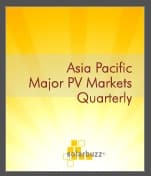A new report on solar panel demand in the Asia-Pacific (APAC) region predicts a capacity increase of 13.5 gigawatts in 2013 and forecasts a healthy growth rate of 50 percent year-over-year.
Industry analyst firm NPD Solarbuzz’s Q1, 2013 Asia Pacific Major PV Markets Quarterly shows 90 percent of solar demand coming from China, Australia, Japan and India, but as domestic policies change, suppliers must adapt to changing circumstances.
“Having a single go-to-market strategy to meet growing PV demand across the entire APAC region is no longer viable,” stated Chris Sunsong, analyst at NPD Solarbuzz. “Quarterly cycles also continue to define PV demand, reflecting the effects of policy deadlines and weather-related seasonality.”
Solarbuzz say solar PV growth will slow in Australia in 2013 after the early axing of the Solar Credits Multiplier scheme and the feed-in tariff situation in Victoria and Queensland.
Government incentives, trade restrictions and technology will have the most impact on market expansion in the solar sector this year. Japan’s planned cuts to subsidies in April will see the majority of demand peak in the first quarter, with a focus on high-efficiency solar modules suited for built-up areas.
In China, the world’s solar manufacturing behemoth, demand for solar energy capacity is forecast to grow by seven gigawatts in 2013, with over 75 percent occurring in the second half of the year. But the report warns potential feed-in tariff adjustments should allow projects to be completed earlier in the year, to avoid last-minute panic buying of materials.
Under Phase Two of India’s National Solar Mission – which ambitiously aims to deploy 20,000 MW of grid connected solar power by 2022, and which is also facing a challenge from the United States for allegedly breaching global free trade requirements for its domestic supplier clause – one gigawatt of demand is to come from roof-top solar and off-grid systems, shrinking the demand for thin-film materials used in large-scale solar farms.
“There are various factors driving overall PV demand across the APAC region, but each country is still subject to a number of risk factors,” added Sunsong. “For example, the Chinese and Indian markets are constrained by bank financing and grid accessibility, and Australia remains vulnerable to future policy shocks.”
















































